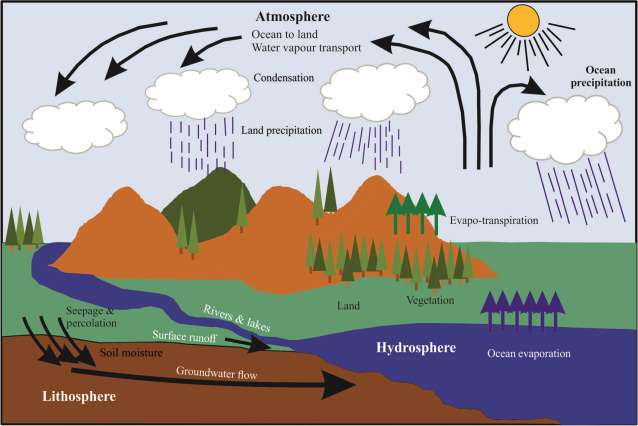Water on the surface of earth is available in the atmosphere, the oceans, on land and within the soil and fractured rock of the earth’s crust. Water molecules from one location to another are driven due to the solar energy transmitted to the surface of the earth from Sun. Moisture circulates from the earth into the atmosphere through evaporation and then back into the earth as precipitation.
Definition
The hydrologic cycle describes the continuous re-circulating transport of the waters of the earth, linking atmosphere, land and oceans.
Related Points:
1) Water evaporates from the ocean surface, driven by energy from the Sun, and joins the atmosphere, moving inland as clouds. Once inland, atmospheric conditions act to condense and precipitate water onto the land surface, where, driven by gravitational forces, it returns to the ocean through river and streams.
2) The process is quite complex, containing many sub-cycles.
3) Engineering Hydrology takes a quantitative view of the hydrologic cycle.
4) The quantification of the hydrologic cycle which is an open system can be represented by a mass balance equation, where inputs minus outputs are equal to the change in storage.
5) It is a basic Hydro-logic Principle or equation that may be applied either on global or regional scale.
I – O = ΔS
The water holding elements of the hydrological cycle are:
1. Atmosphere
2. Vegetation
3. Snow packs
4. Land surface
5. Soil
6. Streams, lakes and rivers
7. Aquifers
8. Oceans
Hydrologic Cycle Process:- For the completion of a hydrologic cycle it involves the following process
1. Precipitation
2. Evaporation
3. Transpiration
4. Infiltration
5. Overland flow
6. Surface Runoff
7. Groundwater outflow
Key Components of Hdrologic cycle :
1. Precipitation
2. Runoff
3. Storage
4. Evapotranspiration
The hydrologic cycle is a model of the movement of water through the Earth system. It also is a pathway through which energy is transferred between the surface of the earth and the atmosphere.
Water-Budget Equation
The water-budget equation is simple, universal, and adaptable because it relies on few assumptions on mechanisms of water movement and storage. A basic water budget for a small watershed can be expressed as:
P + Qin = ET + ΔS + Qout …. …. (1)
Where
P is precipitation,
Qin is water flow into the watershed,
ET is evapotranspiration (the sum of evaporation from soils, surface-water bodies, and plants),
ΔS is change in water storage, and
Qout is water flow out of the watershed.
Applications in Engineering :-
1) Hydrology is used to find out maximum probable flood at proposed sites e.g. Dams.
2) The variation of water production from catchments can be calculated and described by hydrology.
3) Engineering hydrology enables us to find out the relationship between a catchment‟s surface water and groundwater resources.
4) The expected flood flows over a spillway, at a highway Culvert, or in an urban storm drainage system can be known by this very subject.
5) It helps us to know the required reservoir capacity to assure adequate water for irrigation or municipal water supply in droughts condition.
6) It tells us what hydrologic hardware (e.g. rain gauges, stream gauges etc) and software
(computer models) are needed for real-time flood forecasting.
7) Used in connection with design and operations of hydraulic structure.
8) Used in prediction of flood over a spillway, at highway culvert or in urban storm drainage.
9) Used to assess the reservoir capacity required to assure adequate water for irrigation or municipal water supply during drought.
10) Hydrology is an indispensable tool in planning and building hydraulic structures.
11) Hydrology is used for city water supply design which is based on catchments area, amount of rainfall, dry period, storage capacity, runoff evaporation and transpiration.
12) Dam construction, reservoir capacity, spillway capacity, sizes of water supply pipelines and
effect of afforest on water supply schemes, all are designed on basis of hydrological equations.
